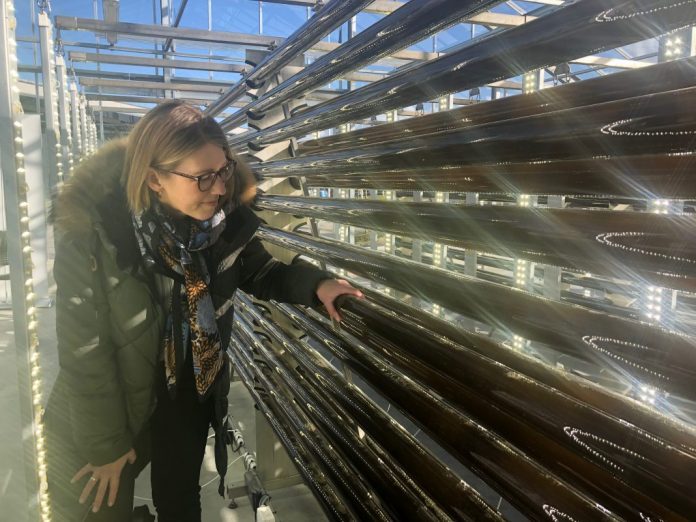They feed on sunlight and carbon dioxide. The algae can feed up the fish.
Long transparent glass tubes are vertically stacked up against the glass roof. Through the pipes flushes muddy water. It’s hot inside the greenhouse. Solar heat and carbon dioxide are input factors for what will become a diet for farmed fish. The green water of the algae is used as a source of nutrients for plankton, such as crustaceans and artemias, which are feed sources for wrasse.
Cleaner fish have become the largest farmed fish species in Norway after salmon.
“One of the goals is to lower the fish in the fish-out-ratio in feed,” said Department Director of the research institute NORCE Hans Kleivdal.
“These algae, which have very long and difficult names, need carbon dioxide from CO2 captured at TCM (Technology Center Mongstad). The algae we have looked at have different properties, including omega-3 and protein content,” said the Dutch researcher Dorinde Kleinegris at NORCE.

Open
“We can help solve climate challenges. It’s not a solution, but its a way of contributing,” said Kleivdal, pointing out that this site connects two of Norway’s largest industries.
“The Algepilot, which is an open research facility, is owned and run by the University of Bergen, NORCE and the consortium CO2Bio, owned by the two and the industry,” Kleivdal continued.
Involved within the industry, she said are Lerøy, Mowi, Grieg Seafood and Cargill.
Production at the so-called algae pilot plant takes place in a greenhouse close to Equinor’s oil refinery in Mongstad, Hordaland county, on the west coast of Norway.

More value chains
Tanja Hoel is well-known for her role as Managing Director of the network organisation at NCE Seafood Cluster, whose owners have financed the algae pilot. She recently left for pastures new and is now the business manager for Alvær municipality, also in Hordaland county.
“In my portfolio, this is how we can develop Mongstad towards “the green shift”. We will link several value chains together. The algae pilot is an example of this, but it’s far from the only thing,” she said to SalmonBusiness.
Just beside the algae plant, the forest engulfs the steel towers from the oil refinery. Gas and flames flicker from the chimneys.
Transfer of knowledge
“We are proud of Mongstad. There are 3,000 people working here, more than 100 companies. Tapping into the transfer of expertise here is a priority for us,” she said.
“We must have global ambitions locally by taking the lead into a circular economy,” she added, with that she means recycling of renewable resources. Zero waste. Everything must be put to use.
“We have all input factors present: We have the technology, expertise, infrastructure, great access to renewable resources and a world-leading research and university environment in the field. So here it is about going into layers and taking an accelerated move towards the green shift.
“This is just the beginning,” engagedly concluded Hoel.


